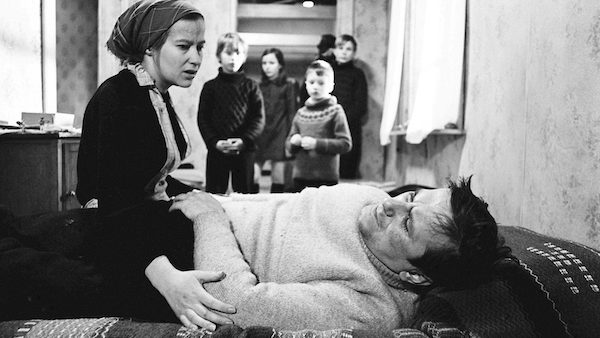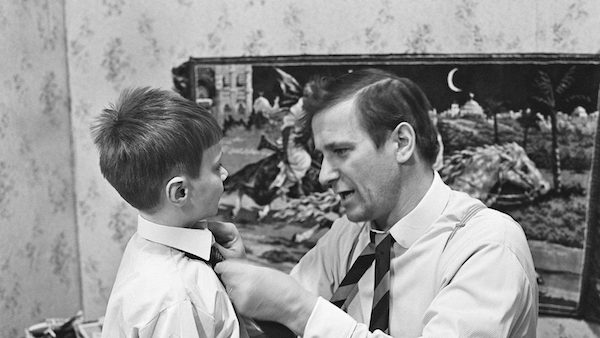Film Review: Of Farms and Fate — “Eight Deadly Shots” and “Alcarràs” at the New York Film Festival
By David D’Arcy
Two films look at the hardships and realities of rural life, past and present, at the New York Film Festival.

A scene from Mikko Niskanen’s Eight Deadly Shots.
Eight Deadly Shots, the 1972 epic of poverty and alcoholism in rural Finland by Mikko Niskanen, earned its reputation long ago but never found the audience it deserves. With a restoration that played at the New York Film Festival, that could change.
In black-and-white, and more than five hours long, filmed entirely in one isolated location, Eight Deadly Shots originated as a four-part series for Finnish television. Niskanen plays the lead character, Pasi, a convivial but struggling father of four children who survives on selling and working at whatever he can find.
Finland these days has been called the happiest country in the world, a distinction that might need some clarification if you know the brooding films of Aki Kaurismaki (who admires Niskanen). In Niskanen’s series we’re looking at an earlier era, or what seems like the end of an earlier era. Think of it as Finland long before Nokia — long, long before. Life is as hard as the Finnish winters, and the arrival of elements of the modern world to these hinterlands isn’t making it easier for people like Pasi.
In an on-screen prologue, Niskanen writes that the story is drawn from real life — it’s inspired by a mass shooting of four policemen in 1969. “Everyone may have his own truth, but this is the one that I saw and experienced, having been born in these surroundings, having lived this particular life and having studied these matters.” Watching the director play the hardworking and tempestuous Pasi, you see that this is a statement that he’s not making lightly.
“Booze was the root of all evil in our family,” the filmmaker adds.
Eight Deadly Shots shows us a family that’s being left behind as the traditional economy of its isolated world changes. Niskanen’s film is epic in length but exact regarding the most minute details. Tender but starkly realistic, this saga was, for me, the discovery of the New York Film Festival.
The story here fits what has become a familiar picture of rural isolation and a hardscrabble life. Pasi barely earns anything, so he gets by making moonshine, with the help of his close friend Reiska. They produce their much-admired brew in the woods. Selling it is illegal, but their product is popular. Pasi’s fatal flaw is that he shares and drinks a lot of his whiskey and he is a mean drunk who argues and fights. We learn that alcohol brought an early death to his father.
His wife and the mother of their children, Vaimo (Tarja-Tuulikki Tarsala), a serene presence when Pasi is sober, offers constant warnings about drinking. She flees the house when Pasi’s had too much. In the film’s scenes of family life, she has a gentle Bressonian forbearance, a soothing affection — until booze enters the picture.
There is more than serenity and quiet strength to Vaimo. Dragging heavy cans of fresh milk through knee-deep snow while Pasi chops wood, she is scolded by the smug driver of a new car who accuses her and her husband of producing too much milk from their cows. “If these drops of milk from us small farmers are overproduction, the almighty masters can drink their own piss,” she tells the man. “We’re done with you.” More note would have been taken of Tarsala’s career if she had acted in a widely spoken language. Here is a chance for us to catch up.

A scene from Eight Deadly Shots.
Given the title and the opening sequence — the shooting of four policemen and their grand funeral (grand, that is for rural Finland) — we can see where this story is going.
Structuring his film as an extended flashback, Niskanen gives us a vivid sense of time, place, and society. The camera lingers on the objects in the spare interior of Pasi’s home, on the grueling work of cutting trees in a thick snowfall, and on the logistics of moonshining, which are so carefully presented that the filmmakers themselves might have violated some laws. Finland and Finns have long struggled with alcohol. The country passed its own Prohibition laws from 1929 to 1932. It didn’t work. Illegal distilling in the countryside soared.
Eight Deadly Shots is not a film that celebrates the harmonies of rural life, which is seen as repetitive, but also improvised, with farmers surviving however they can. They are routinely short-changed and cheated by middlemen whom they despise. Pasi and Reiska smirk as they cut every corner to make an extra buck. All the while, Pasi’s young children fear what happens when their father drinks too much.
If there is a cinematic influence on Niskanen, it would not seem to be his Swedish neighbor, director Ingmar Bergman. Niskanen cited Tarkovsky when asked, but Bresson comes to mind, especially in close-ups of Pasi’s children and Tarsala, as the patient Vaimo navigates the everyday challenges of marriage and motherhood.

A scene from Eight Deadly Shots.
Eight Deadly Shots’ touching scenes of family life are especially delicate, despite the austere surroundings. You see another touch of Bresson (echoes of Au Hazard Balthazar) in the film’s treatment of animals. Desperate, Pasi cuts and hauls wood, and in one scene coaxes his horse to keep trying after the sledge, overloaded with logs, becomes stuck in the deep snow. When his money’s almost gone, the discouraged man reluctantly sells the horse to stingy buyers, and pleads with them to go easy on the loyal aging animal. It’s a heartbreaking moment.
That grim episode, like much of Eight Deadly Shots, feels foreordained. There is a fatalism to the film’s many scenes of drinking and drunkenness, warm and festive before they turn violent, almost always triggered by Pasi pouring free moonshine for his friends, with plenty of beer chasers.
Eight Deadly Shots premiered on Finnish television in 1972, at a time when there was no commercial programming to compete with a tale, more than five hours long, about the toll of alcohol on a working-class family. In those days, in Europe and everywhere else, marijuana, LSD, and cocaine were the “cool” intoxicants. Yet state television was a somewhat protected environment where filmmakers could experiment, as Rainer Werner Fassbinder showed in 1972-73 in Germany with his government-funded five-part series Eight Hours Don’t Make a Day, about working class characters in family and factory settings. And Eight Deadly Shots won its handful of fans at the time. The farmer-turned-killer on whom it’s based praised the film from prison. Martin Scorsese was another admirer.
The film raised serious political questions 50 years ago. Like most classics, it still does, and still straddles the political barricades. Pasi’s plight is that of the indebted small farmer who is overtaxed and over-regulated — constant complaints from some in the Nordic countries. He is also a man pleading for a job, or for any work — the kind of rural rebel with guns in his house who might have voted for socialists decades ago. Those farmers tend to support the Right these days.
Pasi anticipates the abandoned characters who turn up in recent Finnish cinema, as in the deadpan films of Aki Kaurismaki, men and women overwhelmed by life (and by booze). The Icelandic director Fridrik Thor Fridrikson, a Kaurismaki contemporary, explored some of the same territory more than three decades ago in 1987’s White Whales, where two grizzled whalers on the wrong side of the zeitgeist vent their frustrations when they come ashore.
Farms and family in the present are the subject of Alcarràs, a Catalan drama which also played at the New York film Festival, where it was overshadowed by more star-powered offerings.
It couldn’t be more current. In Catalonia (Catalunya), the Solé family grows peaches. These are lands that you might have driven through around Barcelona on the way to or from the beach. The business is a struggle. It’s labor intensive, weather is a risky factor, as are irrigation and quick harvesting and predation of the fragile tree trunks by rabbits, which family members are constantly shooting. (A film that could be accused of being anti-solar and anti-rabbit. How’s that for a marketing challenge?)
Things are getting worse. The family has already begrudgingly sold off some of its orchards for the installation of solar collectors, with the prospect of having to unload more land to support what they have left. African immigrants help pick the fruit, but even they have become too expensive. Amid these worries, a teenage son is growing marijuana among the peach trees. At least it’s the family farm.
Failure seems over the horizon, but tragedy hasn’t hit, at least not yet. The brood’s younger generation seems impervious, growing up in an extended family living on ancestral land. In this story of a farm that’s become a lagging business, director Carla Simón gives us plenty of family rough and tumble, amid the stress that comes with the encroachment of progress — for someone else.
Acted by a mostly nonprofessional cast, Alcarràs is scripted, but it feels like a documentary — as if the performers have forgotten the camera is there. It’s an endearing homage to family life, with all of its teasing, bickering, stress, and affection. Scripted or not, the story couldn’t be more real. The film was a hit when it opened in Spain, and it is the Spanish nominee for this year’s Academy Award for Best Foreign Language Film.
David D’Arcy lives in New York. For years, he was a programmer for the Haifa International Film Festival in Israel. He writes about art for many publications, including the Art Newspaper. He produced and co-wrote the documentary Portrait of Wally (2012), about the fight over a Nazi-looted painting found at the Museum of Modern Art in Manhattan.

Is there any animal cruelty in ‘Eight Deadly Shots’?